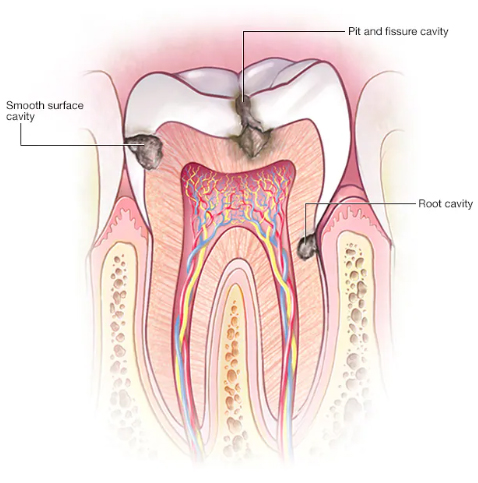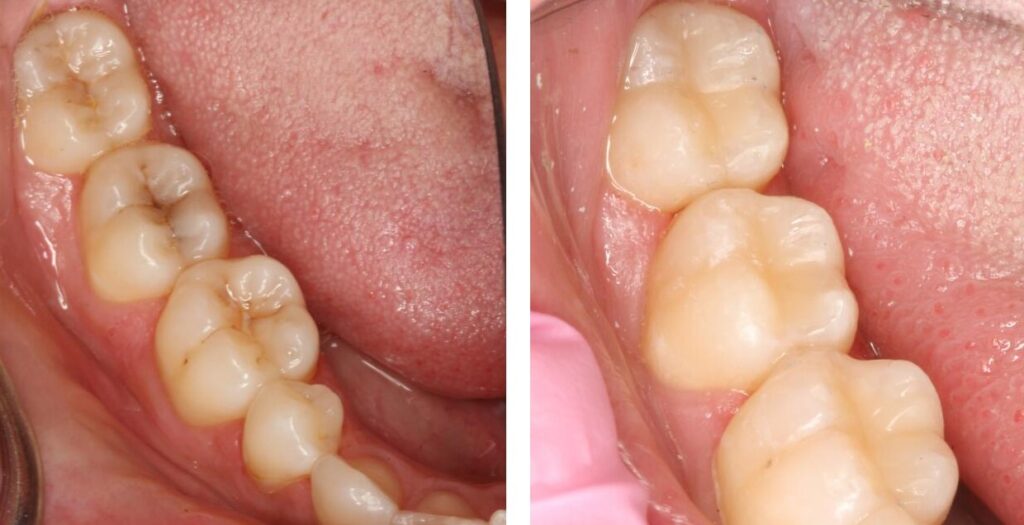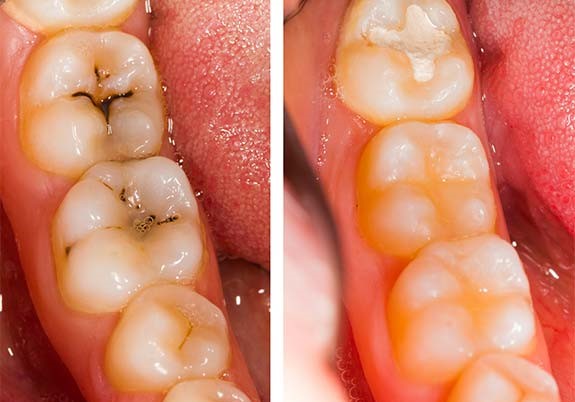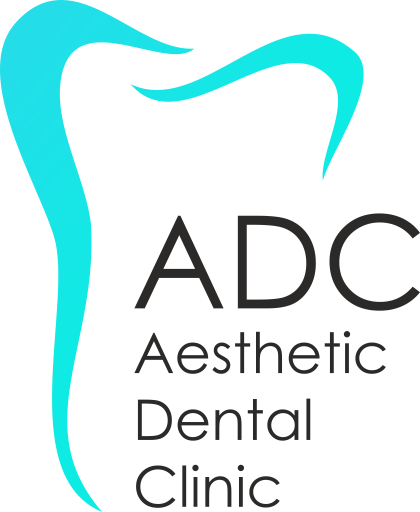Dental Caries is a damaged area on the hard surface of the teeth that develops into tiny holes. Tooth decay is caused by a combination of factors such as bacteria in your mouth, frequent chewing of food, regular consumption of sugary drinks and not cleaning your teeth well.
Tooth decay is one of the most common health problems in the world. It is especially common in children, teenagers and older adults. Anyone with teeth can develop cavities, including infants.
If the “holes” are not treated, they become larger and affect the deeper layers of your teeth. They can lead to severe toothache, infection and tooth loss.
Regular visits to the dentist and good brushing and flossing habits are your best protection against tooth decay.

Tooth decay symptoms
The symptoms of caries vary, depending on their extent and location. When a cavity is in early stage, you may have no symptoms at all. But as the cavity grows, it can cause some symptoms such as:
- Toothache, spontaneous pain or pain that occurs for no apparent reason
- Tooth sensitivity
- Mild to sharp pain when eating or drinking something sweet, hot or cold
- Visible holes or pits in your teeth
- Brown, black or white stain on any surface of a tooth
- Pain when biting
Tooth decay early stages
The initial stage of tooth decay comes in the form of white or brown spots on the surface of the tooth. This happens when the enamel starts to break down. Reversibility of tooth decay at this stage is possible with enamel strengthening toothpaste and various other fluoride treatments.
If the tooth decay advances further then a dental filing will be required.
Early stage

Advanced stage

When should I see the Dentist for Tooth Decay?
You may not be aware that a cavity is forming. That’s why it’s important to have regular dental exams and cleanings, even when your mouth is fine. However, if you experience a toothache or mouth pain, see your dentist as soon as possible.
Stages of tooth decay
The cavities are caused by tooth decay – a process that occurs over time.
Forms of Plaque:
Dental plaque is a clear sticky film that covers your teeth. It’s because you eat a lot of sugars and starches and don’t brush your teeth well. When sugars and starches are not cleaned from your teeth, bacteria quickly begin to feed on them and form plaque. Plaque that remains on your teeth can harden, below or above your gum line, and turn into calculus (tartar). Tartar makes plaque removal more difficult and creates a shield for bacteria.
Acids:
The acids in plaque strip away the minerals in the hard, outer enamel of your tooth. This erosion causes tiny openings or cavities in the enamel – the first stage of cavities. Once areas of enamel wear away, bacteria and acid can reach the next layer of your teeth, called dentin. This layer is softer than enamel and less acid resistant. Dentin has tiny tubes that communicate directly with the nerve of the tooth causing sensitivity.
The destruction continues:
As tooth decay develops, bacteria and acid continue to work their way through your teeth, moving alongside the inner tooth material (pulp) that contains nerves and blood vessels. The pulp becomes swollen and irritated by the bacteria. Because there is no room for the swelling to expand inside a tooth, the nerve is compressed, causing pain. The discomfort can even extend beyond the root of the tooth to the bone, where endodontic treatment will be needed and in the worst cases, extraction will be necessary.
Everyone with teeth is at risk of tooth decay, but the following factors may increase the risk:
Position of the teeth:
Tooth decay occurs most often in your posterior teeth (molars and premolars). These teeth have many grooves, pits and fissures and many roots that can collect food particles. As a result, they are harder to keep clean than your smoother, more accessible front teeth.
Certain foods and liquids:
Foods that stick to your teeth for a long time – such as milk, ice cream, honey, sugar, soda, dried fruit, cakes, cookies, hard candies and mints, dry cereals and chips – are more likely to cause caries from foods that are easily washed away by saliva.
Frequent snacking:
When you constantly snack or drink sugary drinks, you give the bacteria in your mouth more fuel to produce acids that attack your teeth and wear them down. Drinking coca cola, energy drinks like red bull or other acidic drinks during the day helps create a constant acid bath over your teeth.
Feeding babies at bedtime:
When babies are given bedtime bottles filled with milk, juice or other sugary liquids, these beverages remain on their teeth for hours while they sleep, feeding bacteria that cause cavities. Similar damage can occur when toddlers go around drinking from a glass filled with these liquids.
Poor oral hygiene:
If you don’t brush your teeth immediately after eating and drinking, plaque builds up quickly and the early stages of tooth decay can begin.
Toothpaste is fluoride-free:
Fluoride, a natural mineral, helps prevent tooth decay and can even reverse the early stages of tooth damage. It is a common ingredient in toothpaste and mouthwashes.
Teenagers, toddlers and adults:
In general, cavities are common in very young children and teenagers. The elderly are also at higher risk. Over time, teeth can wear down and gums can recede, making teeth more vulnerable to root decay. Older people may also use more medications that reduce the flow of saliva, increasing the risk of tooth decay.
Dry mouth:
Dry mouth is caused by a lack of saliva, which helps prevent tooth decay by washing away food and plaque from your teeth. Substances found in saliva also help fight acid produced by bacteria. Certain medications, radiation to your head or neck, or certain chemotherapy drugs can increase your risk of tooth decay by reducing saliva production.
Worn fillings or dental appliances:
Over the years, dental fillings can weaken, begin to crumble, or develop rough edges. This allows plaque to build up more easily and makes it more difficult to remove. Dental braces can also stop fitting well, allowing tooth decay to start underneath.
Heartburn:
Heartburn or GERD can cause stomach acid to flow into your mouth (reflux), wearing away your tooth enamel and causing significant tooth damage. This exposes more of the dentin to bacterial attack, creating tooth decay. Your dentist may recommend that you see your doctor to see if GERD is the cause of your enamel loss.
Eating disorders:
Anorexia and bulimia can lead to significant tooth erosion and tooth decay. Stomach acid from repeated vomiting (purging) washes away the teeth and begins to dissolve the enamel. Eating disorders can also affect saliva production.
Effects of Dental Caries
Dental Caries is so common that you may not take it seriously. And you might think it doesn’t matter if kids get cavities in their baby teeth. However, tooth decay can have serious and permanent complications, even for children who do not yet have their permanent teeth.
Complications of tooth decay can include:
- Pain
- Tooth abscess
- Swelling or pus around a tooth
- Broken teeth
- Chewing problems
- Shifts in the position of the teeth after tooth loss
When cavities and decay become severe, you may have:
- Pain that interferes with daily life
- Weight loss or feeding problems from painful or difficult chewing
- Loss of teeth, which can affect your appearance, as well as your confidence and self-esteem
- In rare cases, a dental abscess – a pocket of pus caused by a bacterial infection – can lead to more serious or even life-threatening infections
Treatment of Dental Caries
Good oral and dental hygiene can help you avoid tooth decay.
Below are some tips to help prevent tooth decay. Ask your dentist which tips are best for you.
- Brush with fluoride toothpaste after eating or drinking: Brush your teeth at least twice a day, and ideally after each meal, using toothpaste that contains fluoride. To clean between your teeth, floss or use interdental brushes.
- Rinse your mouth: If your dentist thinks you’re at high risk for tooth decay, they may recommend using a fluoride mouthwash.
- Visit your dentist regularly: Get professional teeth cleanings and regular oral exams, which can help prevent problems or detect them early.
- Preventive Fillings: A preventive filling is a protective resin coating applied to the chewing surface of the back teeth. Seals grooves and crevices that tend to collect food, protecting tooth enamel from plaque and acid. The Centers for Disease Control and Prevention (CDC) recommends preventive fillings for all school-aged children. Preventative fillings can last several years before they need to be replaced, but they should be checked regularly.
- Drink water: It is very important to hydrate the mouth and neutralize the acidic pH.
- Avoid frequent snacking: Every time you eat or drink anything other than water, you help the bacteria in your mouth create acids that can destroy tooth enamel. If you snack or drink acidic liquids throughout the day, your teeth are constantly wearing down.
- Eat teeth-healthy foods: Some foods and liquids are better for your teeth than others. Avoid foods that stick to the grooves and pits of your teeth for long periods or brush them immediately after eating. However, foods such as fresh fruits and vegetables increase the flow of saliva, and coffee, tea, and sugar-free chewing gum help remove food particles.
- Consider fluoride treatments: Your dentist may recommend periodic fluoride treatments, especially if you are not getting enough fluoride through fluoridated drinking water and other sources.
- Ask about antibacterial treatments: If you’re especially vulnerable to tooth decay—for example, because of a medical condition—your dentist may recommend special antibacterial mouthwashes or other treatments to reduce the harmful bacteria in your mouth.
- Combination therapies: Chewing xylitol-based gum along with prescription fluoride and an antibacterial mouthwash can help reduce the risk of tooth decay.
How Dental Caries Go Away?
If the decay is not too severe, your dentist will remove all the decay and repair the tooth with a dental filling. If the damage is extensive the nerve in the middle of the tooth may be damaged. If the nerve is damaged then endodontic treatment will need to be done and then repairing the tooth with a dental filling or dental crown. If the tooth is so damaged that it cannot be repaired, the dentist may need to extract the tooth.





